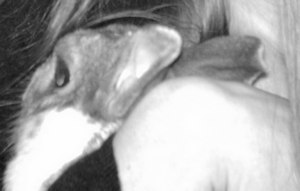One of the most common questions I get from fellow owners of pet rabbits is, “Can pet rabbits have baths?” Most vets and websites geared toward caring for pet rabbits will tell you that you should not bathe your bunny unless you absolutely have to, because there are so many risks. The stress of the bathing process can easily cause a heart attack in pet rabbits. If you don’t hold bunny properly, or if he kicks to get away from the bath, you risk his permanent paralysis or even death, because his spine may snap. Pet rabbits are also very susceptible to chills, and you should never bathe a sick rabbit. Try spot cleaning just the dirty area to avoid a full bath. If you do decide to give your rabbit a bath, here’s the best way I’ve found to do it.
Don’t bathe bunny in the bathtub or the sink. The surfaces of both will be too cold and hard. It’s difficult to hold a rabbit properly in the bathtub, and the height of the sink is too much to risk, if your rabbit does happen to jump out of your arms. Instead, invest in a small baby tub. If you’re in a bind, use a small Rubbermaid bin or small plastic bucket.
Make sure the room you’ll be bathing bunny in, preferably the bathroom, is warm enough. If necessary, turn the heat on or run hot water in the shower so that the steam can warm the room before bath time. When preparing bunny’s bath water, use lukewarm water. Do not use commercial flee shampoos unless a vet that specializes in rabbits has said it’s okay. If my rabbit is especially messy, I will use baby shampoo.
Unlike dogs and cats, pet rabbits can’t have water poured over their heads. In fact, you should avoid getting your rabbit wet at all from the neck up. You should be especially careful to keep the ears and nostrils dry. For this reason, using only a few inches of water in the tub is best. Since it is probably the rabbit’s bottom that will be dirty, take into account how tall your rabbit’s back legs are to know exactly how much water you’ll need.
When you go to put your rabbit in the tub, don’t hold him under the “arms” — if he kicks or struggles to get away, his spine might snap. Instead, hold your rabbit close to you in the crook of one arm, belly down, with his front legs and head over your arm. This way, you can dunk bunny’s back half down in the water while keeping the front half mostly dry, and at the same time, you’ll cut down on the chance of injury even if he kicks with his back feet.
When cleaning a poopy rabbit, don’t rub with a washcloth or sponge, as this can irritate or break the skin. If the poop is dried on, you may want to use rubber gloves to pull off the clumps as gently as possible — I use the kind made for washing dishes. Be careful of the genitals. If you use baby shampoo, only use a tiny bit, and make sure it gets rinsed off.
Upon taking bunny out of the bath water, wrap him in a towel and lightly scruff the fur to help it dry faster. A wet rabbit can take hours to dry completely on its own, and if it gets a chill, there is a good possibility that the rabbit will get sick. I don’t recommend blow drying a rabbit, because the noise scares them, and even the warm heat setting can be too much. The stress of the actual bath is risk enough. I’ve found that using three or four towels is usually enough to get my pet rabbits fluffed dry, but it takes at least an hour.
As the owner of pet rabbits, you probably already know that bunnies aren’t exactly low maintenance pets. Bathing them is one of the more time consuming and stressful responsibilities that comes with being a rabbit owner. My two pet rabbits are four and two years old, and I have had to give both of them at least a few baths every year. Because I love them so much, I have tried very hard to find ways to get around bathing them. Sometimes, though, you just have to do it. I hope the above tips and lessons I’ve learned the hard way will help you keep your pet rabbits safe. When in doubt, always consult your vet about your pet rabbits’ health and care.





